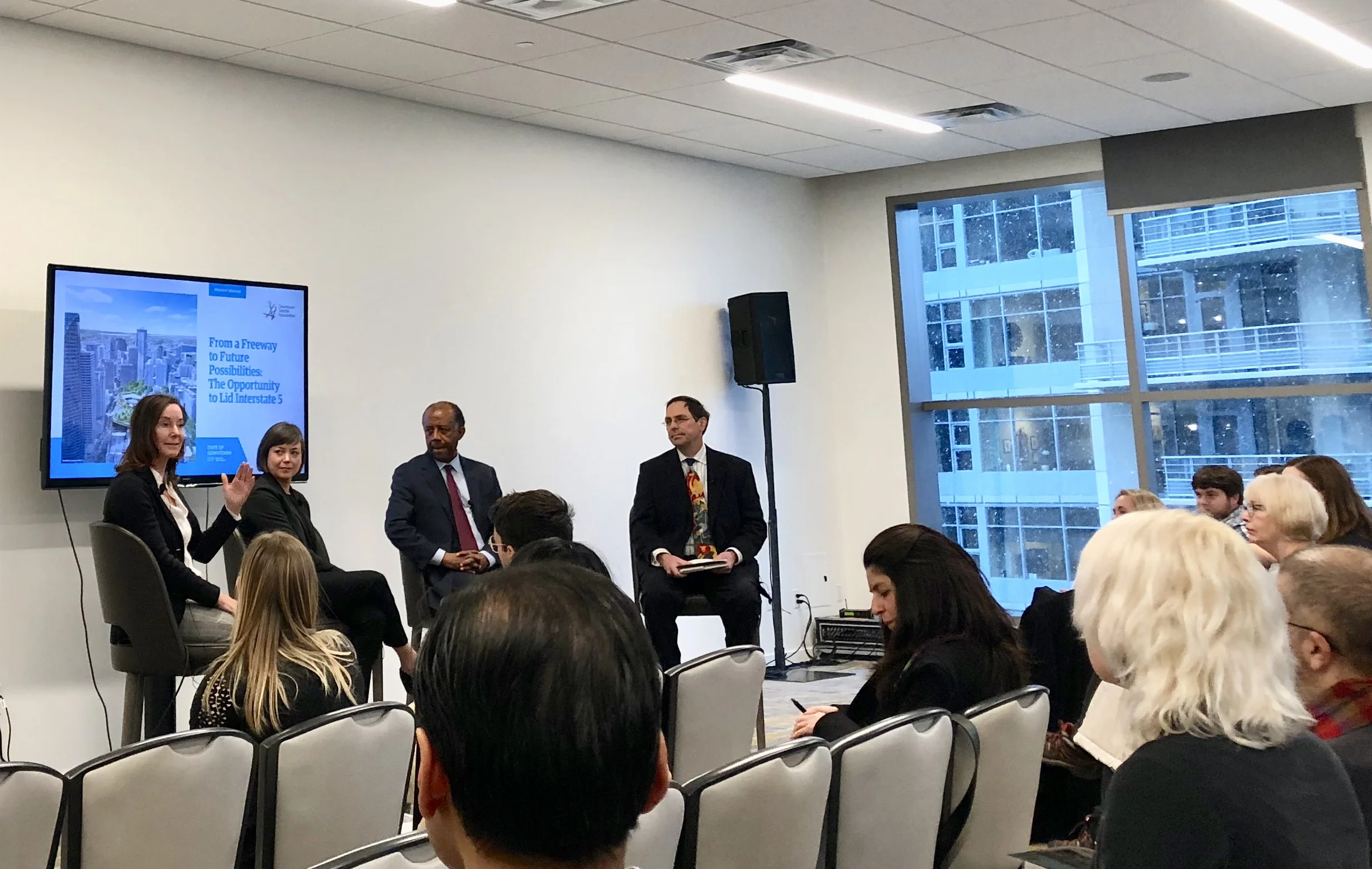State of Downtown (Snow Globe Edition)
On Friday, I attended the Downtown Seattle Association’s “State of Downtown.” The emerging snowpacolypse did not deter the 1,300 people who attended at the Hyatt Regency. In the afternoon, breakout sessions were held on important topics, including “From Freeway to Future Possibilities: The Opportunity to Lid Interstate 5.”
The session was moderated by Larry Costich (Attorney, Schwabe, Williamson & Wyatt) with a panel including:
Liz Dunn (Principal, Dunn + Hobbes, LLC)
Karen Thompson (Director of Planning, Delaware River Waterfront Corporation)
Sam Assefa (Director of Office of Planning & Community Development)
Panel session. Notice the flakes in the window, which did not dampen enthusiasm.
As members of the Lidding I-5 Committee, Liz Dunn and Sam Assefa shared the following insights:
Local opinion was divided on constructing I-5 from the get-go; First Hill residents led opposition efforts because of fear of isolation from downtown.
Communities and homes were destroyed, with residents displaced.
Over time, I-5 created a scar, and lidding I-5 provides an opportunity to heal the wound of urban renewal.
The committee is moving forward with a feasibility study, now in the RFP phase, focusing on a pilot project to lid I-5 from Madison to Denny, providing a baseline for further activities.
The study will also help gather important data and compile information to determine fundamentals of the project.
Lidding I-5 will help provide sorely needed public space, provide environmental benefits, and is economically a better value than buying existing land downtown.
Lidding I-5 creates an opportunity to increase density in closer proximity to desired amenities, rather than promote growth in areas that are further away, while adding to traffic congestion.
It is critical to engage WSDOT and other partners to creatively address solutions (freeway is aging quickly and costs are increasing to replace it; what will freeways look like in 20-30 years?)
Freeway Park, July 1976. Image courtesy Seattle Municipal Archives: http://archives.seattle.gov/digital-collections/index.php/Detail/objects/11634
The movement for freeway lids is first attributed to Seattle’s Freeway Park in 1976. Many other cities have completed similar projects, or are in the planning stages. Here is a comprehensive map pinpointing where they are (some places will likely surprise you).
Karen Thompson also spoke about her experience at Penns Landing in Philadelphia. Penns Landing is a historical commemoration waterfront site that is separated from the rest of the city by I-95. The Delaware River Waterfront Corporation, in collaboration with other agencies, are embarking on a master plan to cap 12 acres of the freeway and build additional green spaces with amenities like an skating rink. Similar to the goals for lidding I-5, the Philadelphia project is intended to improve accessibility to the rest of the city and the waterfront.
I am familiar with this transformative project through my work at The Durst Organization. During my visits to Philadelphia, I can see great potential at the site and a city that is rallying around the concept. As Seattle’s I-5 lid feasibility study is completed and further contemplated, perhaps there will be a growth of support as Seattleites realize the benefits.
To garner support, I think it’s also critical to engage the historical imagination. In 1961, Paul Thiry (who was Principal Architect for the 1962 World’s Fair), serving as a member of the City Planning Commission, wanted to lid all of I-5 through downtown Seattle, sensing how the freeway can create isolation. After I-5 was built, Freeway Park and later the Convention Center were built as lids, with a number of proposals in intervening years, not to mention lids on I-90 and 520. I-5 “as is” is certainly not a given.
Protestors march across Spring Street demonstrating opposition to freeway construction, Seattle, June 1961. Image courtesy MOHAI (Image No. 1986.5.4018.1): https://digitalcollections.lib.washington.edu/digital/collection/imlsmohai/id/2047/rec/37
Thank you to everyone at Downtown Seattle Association for putting together a great event.



